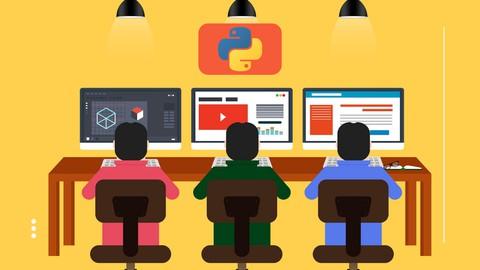Last Updated on July 30, 2023 by GeeksGod
A warm welcome to the Python NumPy Programming and Project Development using NumPy course by Uplatz.
NumPy stands for Numerical Python and it is a core scientific computing library in Python. NumPy provides efficient multi-dimensional array objects and various operations to work with these array objects.
NumPy is a Python library used for working with arrays. It also has functions for working in domain of linear algebra, fourier transform, and matrices. NumPy was created in 2005 by Travis Oliphant. It is an open source project and you can use it freely. NumPy is written partially in Python, but most of the parts that require fast computation are written in C or C++.
Purpose of using NumPy
In Python we have lists that serve the purpose of arrays, but they are slow to process. NumPy aims to provide an array object that is up to 50x faster than traditional Python lists. The array object in NumPy is called ndarray, it provides a lot of supporting functions that make working with ndarray very easy. Arrays are very frequently used in data science, where speed and resources are very important.
NumPy arrays are stored at one continuous place in memory unlike lists, so processes can access and manipulate them very efficiently. This behavior is called locality of reference in computer science. This is the main reason why NumPy is faster than lists. Also it is optimized to work with latest CPU architectures.
NumPy is essentially a library consisting of multidimensional array objects and a collection of routines for processing those arrays. Using NumPy, mathematical and logical operations on arrays can be performed.
NumPy lies at the core of a rich ecosystem of data science libraries. A typical exploratory data science workflow might look like:
Extract, Transform, Load: Pandas, Intake, PyJanitorExploratory analysis: Jupyter, Seaborn, Matplotlib, AltairModel and evaluate: scikit-learn, statsmodels, PyMC3, spaCyReport in a dashboard: Dash, Panel, Voila
Features of NumPy
POWERFUL N-DIMENSIONAL ARRAYSFast and versatile, the NumPy vectorization, indexing, and broadcasting concepts are the de-facto standards of array computing today.NUMERICAL COMPUTING TOOLSNumPy offers comprehensive mathematical functions, random number generators, linear algebra routines, Fourier transforms, and more.INTEROPERABLENumPy supports a wide range of hardware and computing platforms, and plays well with distributed, GPU, and sparse array libraries.PERFORMANTThe core of NumPy is well-optimized C code. Enjoy the flexibility of Python with the speed of compiled code.EASY TO USENumPy’s high level syntax makes it accessible and productive for programmers from any background or experience level.OPEN SOURCEDistributed under a liberal BSD license, NumPy is developed and maintained publicly on GitHub by a vibrant, responsive, and diverse community.
Using NumPy, a developer can perform the following operations −
Mathematical and logical operations on arrays.Fourier transforms and routines for shape manipulation.Operations related to linear algebra. NumPy has in-built functions for linear algebra and random number generation.
Uplatz provides this in-depth training on Python programming using NumPy. This NumPy course explains the concepts & structure of NumPy including its architecture and environment. The course discusses the various array functions, types of indexing, etc. and moves on to using NumPy for creating and managing multi-dimensional arrays with functions and operations. This Python NumPy course also discusses the practical implementation of NumPy to develop prediction models & projects.
NumPy Python Programming and Project Development using NumPy – Course Syllabus
INTRODUCTION TO NUMPYNUMPY TUTORIAL BASICSNUMPY ATTRIBUTES AND FUNCTIONSCREATING ARRAYS FROM EXISTING DATACREATING ARRAYS FROM RANGESINDEXING AND SLICING IN NUMPYADVANCED SLICING IN NUMPYAPPEND AND RESIZE FUNCTIONSNDITER AND BROADCASTINGNUMPY BROADCASTINGNDITER FUNCTIONARRAY MANIPULATION FUNCTIONSNUMPY UNIQUE()NUMPY DELETE()NUMPY INSERT FUNCTIONNUMPY RAVEL AND SWAPAXES()SPLIT FUNCTIONHSPLIT FUNCTIONVSPLIT FUNCTIONLEFTSHIFT AND RIGHTSHIFT FUNCTIONSNUMPY TRIGONOMETRIC FUNCTIONSNUMPY ROUND FUNCTIONSNUMPY ARITHMATIC FUNCTIONSNUMPY POWER AND RECIPROCAL FUNCTIONSNUMPY MOD FUNCTIONNUMPY IMAG() AND REAL() FUNCTIONSNUMPY CONCATENATE()NUMPY STATISTICAL FUNCTIONSSTATISTICAL FUNCTIONSNUMPY AVERAGE FUNCTIONNUMPY SEARCH SORT FUNCTIONSSORT FUNCTIONNUMPY SORT FUNCTIONNUMPY ARGSORT()NONZERO AND WHERE FUNCTIONSEXTRACT FUNCTIONNUMPY ARGMAX ARGMIN()BYTESWAP COPIES AND VIEWSNUMPY STRING FUNCTIONSNUMPY CENTER FUNCTIONCAPITALIZE AND CENTER()NUMPY TITLE FUNCTIONSTRING FUNCTIONSNUMPY MATRIX LIBRARYNUMPY JOIN ARRAYSLINEAR ALGEBRARANDOM MODULESECRETS MODULERANDOM MODULE UNIFORM FUNCTIONRANDOM MODULE GENERATE NUMBER EXCEPT KSECRETSMODULE GENERATE TOKENSRANDOM MODULE GENERATE BINARY STRINGNUMPY MODULE REVISENUMPY INDEXINGNUMPY BASIC OPERATIONSNUMPY UNARY OPERATORSBINARY OPERATORS IN NUMPYNUMPY UNIVERSAL FUNCTIONSNUMPY FILTER ARRAYSNUMPY MODULE PROJECTS














